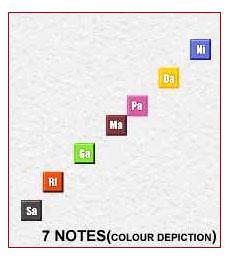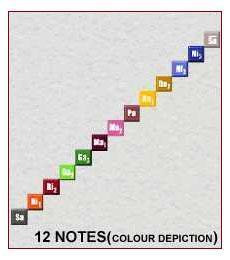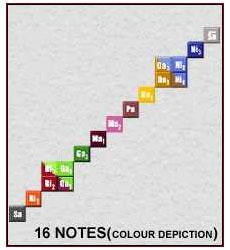|
|
Swaras
Like the Hindustani and Western music
systems, Carnatic music also has seven basic notes called
Swaras.
They are classified based on the increasing order of their pitch. The seven
notes of Carnatic music are given below with their Western equivalents:
The Sapta (seven) Swaras of Carnatic music
|
 |
|
Carnatic swara |
Western note |
|
Shadja - Sa |
Do - C |
|
Rishabha - Ri |
Re - D |
|
Gandhara - Ga |
Mi - E |
|
Madhyama - Ma |
Fa - F |
|
Panchama - Pa |
Soh - G |
|
Dhaivata - Dha |
La - A |
|
Nishada - Ni |
Ti - B |
|
These basic notes are said
to have originated from the Vedic times (Sama Veda). As mentioned
earlier, of these seven notes, Sa is taken as the fixed or
tonic note.
All other notes are in relation to Sa.
The twelve swaras concept
|
The
seven notes are further divided into twelve, which again is a common
feature across the globe. These are also known as Swarasthana.
(Literally swara means note and sthana, position).
Sa
and Pa are the constant notes, (called
Prakriti swaras) i.e., their frequencies do not
change in a given pitch. But the other 5 notes Ri, Ga, Ma, Dha and Ni
(called
Vikriti swaras)
have variable values. |
 |
The sixteen swaras concept
|
 |
As stated earlier,
the octave is divided into twelve parts. Although some of their
melodic values overlap, the twelve Swarasthana-s are given
sixteen names to enable certain combinations. These combinations
provide the scope for a substantial increase in the number of scales
one can get. The scheme of sixteen notes was basically developed for
the derivation of the seventy-two melakarta scheme of
Venkatamakhi (1660 AD). The present day melodic concept has evolved
and changed considerably, influenced by this scheme. |
The following is a table of
the sixteen notes in Carnatic music with their Hindustani equivalents:
|
Carnatic swaras |
Hindustani swaras |
|
1. Shadja - Sa |
Shadj |
|
2. Suddha Rishabha - Ri
1 |
Komal Rishabh |
|
3. Chatusruti Rishabha -
Ri 2 |
Sudh Rishabh |
|
4. Shatsruti Rishabha -
Ri 3 |
Komal Gandhar |
|
5. Suddha Gandhara - Ga
1 |
Sudh Rishabh |
|
6. Sadharana Gandhara -
Ga 2 |
Komal Gandhar |
|
7. Antara Gandhara - Ga
3 |
Sudh Gandhar |
|
8. Suddha Madhyama - Ma
1 |
Sudh Madhyam |
|
9. Prati Madhyama - Ma 2 |
Teevr Madhyam |
|
10. Panchama - Pa |
Pancham |
|
11. Suddha Dhaivata -
Dha 1 |
Komal Dhaivat |
|
12. Chatusruti Dhaivata
- Dha 2 |
Sudh Dhaivat |
|
13. Shatsruti Dhaivata -
Dha 3 |
Komal Nishad |
|
14. Suddha Nishada - Ni
1 |
Sudh Dhaivat |
|
15. Kaisika Nishada- Ni
2 |
Komal Nishad |
|
16. Kakali Nishada - Ni
3 |
Sudh Nishad |
Thus, we have one
variety each of Sa and Pa, three varieties of Ri, Ga, Dha, Ni and
two varieties of Ma.
The four extra names for
the twelve notes
-
When Suddha Rishabha (Ri 1) and Chatusruti Rishabha
(Ri 2) occur simultaneously, Ri 2 becomes Ga 1 (Suddha Gandhara).
-
When Sadharana Gandhara (Ga 2) and Antara Gandhara
(Ga 3) occur simultaneously, then Ga 2 becomes
Ri 3 (Shatsruti Rishabha).
-
Similarly, when Suddha
Dhaivata (Dha 1) and Chatusruti Dhaivata (Dha 2) occur simultaneously,
then Dha 2 becomes Ni 1 (Suddha Nishada).
-
When Kaisika Nishada (Ni
2) and Kakali Nishada (Ni 3) occur simultaneously, Ni 2 becomes Shatsruti
Dhaivata (Dha 3).
|
Ri 2 = Ga 1 |
Ri 3 = Ga 2 |
|
Dha 2 = Ni 1 |
Dha 3 = Ni 2 |
|